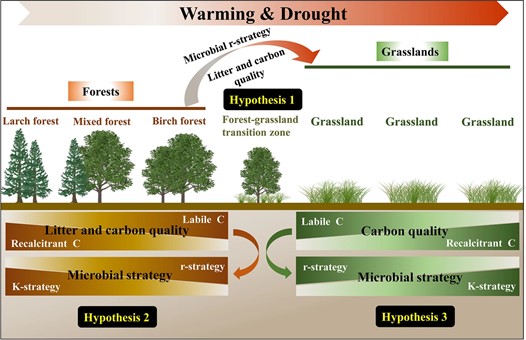Climate Change Impacts Soil Microbes Differently in Forests and Grasslands, Study Finds
A new research highlights how climate-driven vegetation changes influence soil microbial communities, potentially altering carbon storage dynamics in forests and grasslands.
Scientists from the Chinese Academy of Sciences (CAS) have uncovered how soil microbes adapt to climatic gradients, providing fresh insights into their ecological strategies and the potential risks of carbon loss under warming scenarios (Figure 1).
Located on the southern edge of the Eurasian permafrost—permanently frozen ground storing vast amounts of carbon—the forest-grassland transition zone (ecotone) in China’s Greater Khingan Mountains is particularly vulnerable to climate shifts, as shown in the study published in the journal Plant and Soil. As temperatures rise, this permafrost is thawing, releasing greenhouse gases into the atmosphere and further accelerating climate change.
The research team, led by Professor LI Hui from the CAS' Institute of Applied Ecology, examined six sites along a climatic gradient characterized by increasing temperatures and decreasing rainfall. This climatic shift was mirrored by a change in vegetation, progressing from larch forests to birch forests and ultimately to grassland. The team analyzed various soil properties, vegetation characteristics, and, importantly, the microbial communities within the soil, focusing on two distinct life strategies: r-strategists and K-strategists. R-strategists are fast-growing microbes that thrive in rapidly changing environments with abundant resources, reproducing quickly and efficiently consuming available nutrients, much like opportunists. In contrast, K-strategists are slower-growing microbes better adapted to stable environments with limited resources, prioritizing resource conservation and long-term survival, acting as conservators.
The study found distinct differences between how these microbial strategies were affected in forests and grasslands. In grasslands, where plant litter was more abundant and the active portion of soil carbon was higher, r-strategists were dominant. However, as conditions became warmer and drier further south within the grassland sites, the microbial community shifted towards K-strategists, likely due to reduced availability of carbon and nitrogen – key nutrients for microbes. In forest ecosystems, a different pattern emerged. As temperatures increased and vegetation transitioned from coniferous to broadleaved forests, the input of easily decomposable carbon into the soil increased. This stimulated the activity of r-strategists.
The implications of these findings are significant. In a warming world, the shift towards r-strategists in forest soils could accelerate the decomposition of organic matter, leading to greater release of carbon dioxide into the atmosphere. This creates a positive feedback loop, further exacerbating climate change. Conversely, the trend towards K-strategists in grasslands might mitigate carbon loss, as these microbes grow more slowly and are adapted to conserving resources, resulting in more stable carbon storage.
The study highlights the complex interplay between climate change, vegetation, and soil microbial communities. Understanding these intricate relationships is crucial for predicting the future of carbon storage in different ecosystems and for developing effective strategies to mitigate the impacts of climate change.

Figure 1. Contrasting changes in soil microbial ecological strategies and their underlying mechanisms across forest-grassland ecosystems under climate change(Image by DAMG Ning).



